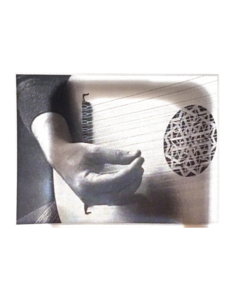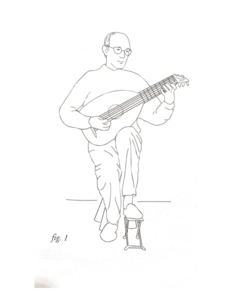2. "Norms": The 21st-century Lute Plucking Technique
2.1. Thumb-in
Presently, it is generally understood that there are two different techniques to pluck the lute – Thumb-in, and Thumb-out. Thumb-in is a way of plucking with the thumb of the right-hand almost constantly positioned in the palm of the hand (also known as Thumbunder). It can be compared to technique used with plectrums, such as on the mandolin. To play fast passages, one would alternate index and thumb (p-i), also known as figueta. (Cf. Video 1: https://youtu.be/7v7LAJTlpUM.)
2.2. “Thumb-out”
Thumb-out (also known as Thumb-over) is commonly known as a way of plucking with the thumb of the right hand constantly positioned above or outside the palm. It is often compared to technique for classical guitar. Fast passages are played by alternating thumb and index (p-i), and also by alternating middle and index (m-i). These terms are used universally today, although they are not the terms used in historical treatises.
2.3. Modern Lute Tutors
In the article written by Martin Eastwell, “21st century Technique: A Compromise too far?”4 Eastwell explains the tendency amongst modern lute players to choose to play Thumb-in regardless of what lutes they play, and that this is often encouraged in modern lute tutors, despite the fact that it contradicts the evidence seen in primary sources. To make his point he quotes a few renowned lute players of today as well as their lute tutors, such as Paul Beier and Andrea Damiani, who advise that Thumb-out technique be reserved for larger lutes that were developed towards the Baroque era (for example, the archlute, theorbo, German and French Baroque lutes).
Eastwell argues in his lecture that the idea that Thumb-out technique was developed for lutes with added bass strings is a myth. He explains that vihuela de mano, which are instruments that have only 5 or 6 courses, were plucked Thumb-out. Moreover, his analysis of 666 iconographies of lutes, show that most of the iconographies of 7 course lutes depicted the lute being plucked Thumb-out.
|
Number of Courses |
6 |
7 |
7/8 |
8 |
9/10 |
|
Thumb-in |
87 |
1 |
0 |
1 |
3 |
|
Thumb-out |
22 |
29 |
10 |
18 |
64 |
Table: Analysis of techniques observed in iconographies by Martin Eastwell5.
Through a survey of modern lute tutors, Eastwell's claim regarding this tendency of modern lute players towards Thumb-in bears out within them as well, although he did not address this in his lecture. Stefan Lundgren's Method6 also opts for Thumb-in and explains its reasons as follows.
Since the Renaissance there have been two basic lute-playing techniques. They differ in the positioning of the right hand and in the variation of the finger movement. […] Thumb under: the hand and the finger are held parallel or nearly parallel to the strings. The thumb is used to pluck the strings behind the fingers in direction to the palm of the hand and the fingers go around and to the outside of the thumb. In this technique the little finger supports itself on the soundboard and the strings are plucked with the fingertips. THUMB UNDER: the hand and the fingers are held vertical or almost vertical to the strings. The thumb is used to pluck the strings before the fingers and the fingers pluck the strings in the direction of the palm of the hand. The THUMB UNDER playing technique method had its origin with the Medieval plectrum playing. Here the fingers barely move and the entire lower arm is used in a stroking motion. After the beginning of the 16th century, finger playing replaced plectrum playing and the stroking motion came more from the fingers than from the lower arm. In the long one-voiced runs that were popular in Renaissance lute music, the alternating stroke between thumb and and forefinger dominated. […] At the end of the 16th century, a new musical style brought about changes in the building of lutes and in the related playing techniques. A more diversified and moving bass part demanded additional bass strings to be placed on the lute and with this, the thumb was more actively involved in playing the bass register. […] In this book you are now reading the thumb under technique is taught and it is the most often used method among professional lute players at this time.
The tendency explained by Eastwell, that modern methods are not necessarily derived from historical sources, has been corroborated by sometimes what the authors of these tutors suggest themselves. Omitting further instructions regarding positioning of the right hand, Toyohiko Satoh states the following.
Although there was certainly more than one standard right-hand technique throughout the history of the lute, present-day technique on baroque lute is similar to modern classical guitar technique. The right hand is normally held between the rose and the bridge, with the thumb extended toward the rose and the little finger rests on the soundboard.7
It takes a great deal of patient practice to pluck both strings at the same time in such a way as to produce a round, precise and beautiful sound. To help you, we have taken a rather unconventional approach, in order to familiarize you with your lute from a sensorial physical point of view.8
This tutor by Serdoura includes very detailed and painstaking explanations of ornamentations, composers and repertoire for the Baroque. However, the right-hand technique explained by Serdoura differs greatly from how Baroque lute treatises explain it, as I will further describe in the following chapter. In addition, though Serdoura does not employ the terms “Thumb-in” and “Thumb-out”, he describes the historical transition of right hand technique thus: “At the close of the 16th century, the technique that consisted in alternating the thumb and the index finger when playing a melody line “figueta” by the Italians, became obsolete. Instead, the melody was played by the index and middle fingers, and the thumb
played the bass.”14 The chapter ahead will address the accuracy of this narrative, of the development of the lute influencing development of the lute influencing whether to employ whether to employ p-i or p-m.
In Thumb-in, either middle or the little-finger side of the fingertip (depending on which finger) makes contact with the strings. Therefore, it can be argued that, if the lute player had first learned Thumb-in when they started with the instrument, it is natural that their memory in the fingertips will influence as they try to learn a technique that is different, or so-called “Thumb-out”, unless great caution is taken. I myself used to pluck the theorbo as Serdoura suggests when I first started to play the theorbo and I faced exactly the same problems explained by Damiani. Damiani’s claim that Thumb-out can cause the fingers to not have sufficient space to move, and increase the risk of hooking the double-strung strings causing them to collide, can be marked in the photograph given by Serdoura (Figure 2.) In figure 2, Serdoura’s index, middle and ring fingers are positioned ready to pluck the strings upwards, laterally to the soundboard. Hooking strings and clashing them occurs easily when the fingers move across the strings laterally to the soundboard rather than diagonally. Moreover, if the thumb and other fingers touch when the thumb needs to pluck strings adjacent or close to those of the other fingers, or in Serdoura’s words, when the hand is closed, as in plucking intervals of 6ths or 3rds, the space around the thumb and fingers is limited, meaning producing and controlling sound becomes more difficult. (See video example 218 https://youtu.be/5Z7zmlp_K3U.) From this, we may surmise that the Thumb-out method explained by Damiani and the technique explained by Serdoura are extremely similar. Serdoura’s way of plucking is in common use among modern lutenists, perhaps due to similarity to Thumb-in, which is, as I discussed, the most popular technique today. To summarize Damiani's complaints, Thumb-out, as it is typically applied or understood today, faces the following four risks: too harsh a sound in trebles, fingers getting in the way of each other, double-strung strings clashing with each other and lastly, the index finger plucks higher courses than the middle finger.. These issues do not arise in Thumb-in except for the last, and though in most cases applying p-i alternation id est, figueta would solve the problem, no solution is available if the thumb is required for plucking a monign base line simultaneously. A further disadvantage of the Thumb-in approach, beyond it lacking a historical foundation in some repertoires, is that one would need to make very quick shifts with the thumb from higher courses (video example 319: https://youtu.be/QCqT6e6MGno.) Lastly, applying Thumb-in for lutes with large bodies, such as baroque lutes or theorbos, can cause the habit to bend one’s torso to the right, in order to align the hand and arms with the strings.
4Martin Eastwell, (2012), p. 11.
5Eastwell, 2012, p. 18.
6Stefan Lundren, Method for Renaissance Lute (Munich: Tree Edition, 1991), p. 5.
7Toyohiko Sato, Method for the Baroque Lute (Munich: Tree Edition, 1987), 9.
8Miguel Serdoura, The Method for Baroque Lute (Bologna: Ut Orpheus Editione, 2008), 72.
9Serdoura 2008, p. 72.
10Serdoura 2008, p. 76.
11Serdoura 2008, p.73.
12Andrea Damiani, Method for Renaissance Lute (Translated by Doc Rossi. Bologna: Ut Orpheus Editione, 1999).
13Damiani 1999, p. 15.
14Serdoura 2008, p. 22.
15Lundgren, 1991, p. 5.
16Damiani 1999, p. 133.
17Damiani 1999, p. 132-133.
18From this video it can be observed that my thumb is sometimes touching the index, not having space to move, and that consequently the thumb is only plucking one string instead of two strings. (video. 2)
19From this video it can be observed that my thumb plays a few ornamental notes on the treble courses upon the dominant chord, and then jumps to the 7th course to play the dominant. (video. 3)



